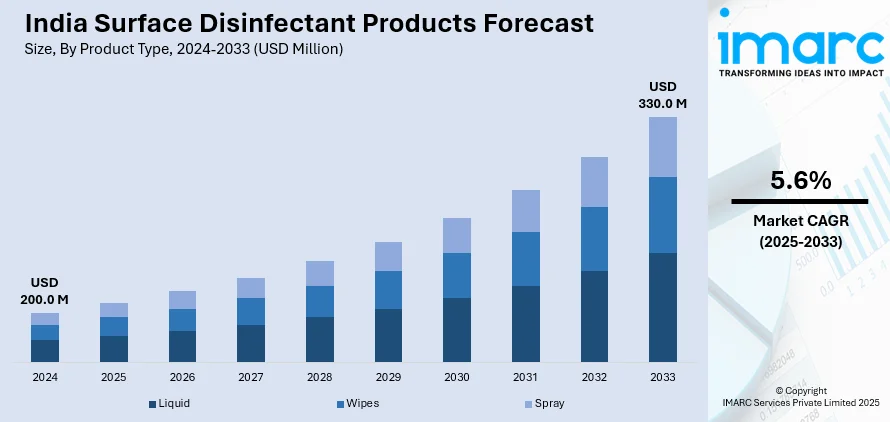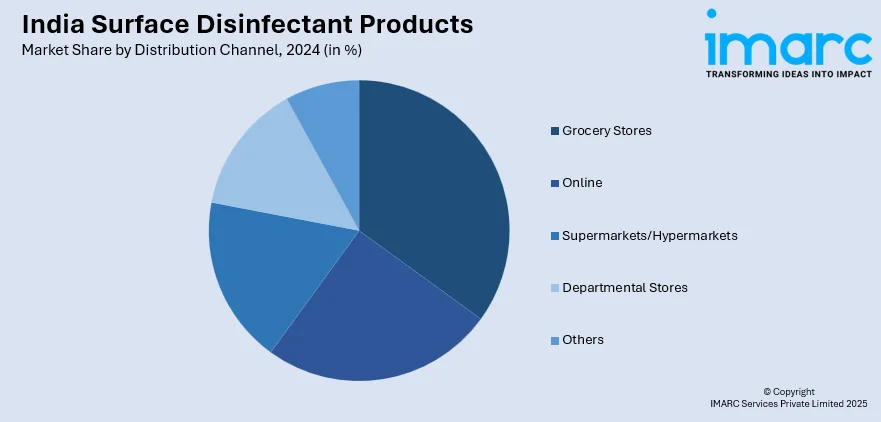
India Surface Disinfectant Products Market Size, Share, Trends, and Forecast by Product Type, Type, Distribution Channel, End User, and Region, 2025-2033
India Surface Disinfectant Products Market Overview:
The India surface disinfectant products market size reached USD 200.0 Million in 2024. Looking forward, IMARC Group expects the market to reach USD 330.0 Million by 2033, exhibiting a growth rate (CAGR) of 5.6% during 2025-2033. The market is growing rapidly due to increased hygiene awareness, heightened by health concerns and the COVID-19 pandemic. Consumers and businesses are shifting towards eco-friendly, effective disinfectants, driving innovation in formulations, and further contributing to the market growth. Additionally, government support and sustainability trends further contribute to market expansion.
|
Report Attribute
|
Key Statistics
|
|---|---|
|
Base Year
|
2024 |
|
Forecast Years
|
2025-2033
|
|
Historical Years
|
2019-2024
|
| Market Size in 2024 | USD 200.0 Million |
| Market Forecast in 2033 | USD 330.0 Million |
| Market Growth Rate 2025-2033 | 5.6% |
India Surface Disinfectant Products Market Trends:
Rising Demand for Hygiene and Safety Amid Health Concerns
The India surface disinfectant products market witnessing an increase in the demand, principally influenced because of increased awareness about hygiene and safety, especially in the wake of the COVID-19 pandemic. As consumers and enterprises emphasized cleanliness, the use of disinfectants has grown across sectors such as residential, commercial, healthcare, and hospitality. The necessity of routine disinfecting in residential settings, offices, hospitals, and public areas has given rise to a wider variety of surface disinfectant products, such as sprays, wipes, and concentrated formulas. The market growth is also influenced by growing fears of the transmission of germs, bacteria, and viruses. In addition to this, government support of hygiene habits in the workplace and public environments continues to support the market growth. For instance, in October 2024, the Indian Pharmacopoeia Commission (IPC) announced the launch of an updated draft guidance on disinfectants and antiseptics in drug manufacturing facilities. It highlights the importance of preventing contamination while using these agents, addressing issues like residual disinfectant removal, and outlining specific areas for cleaning in GMP environments. Furthermore, the trend is likely to persist, with growing awareness of health hazards, especially in urban areas.

To get more information on this market, Request Sample
Growth of Eco-Friendly and Natural Disinfectants
A significant shift in consumer preferences towards eco-friendly, natural, and sustainable surface disinfectants is influencing the India market. As environmental awareness grows, consumers and businesses alike are increasingly opting for products with biodegradable ingredients and minimal chemical content. Brands are responding by offering surface disinfectants made from plant-based and non-toxic substances that maintain high efficacy without harming the environment. For instance, in March 2025, TABBSZ announced offering eco-friendly cleaning solutions using plant-based ingredients and food-grade surfactants. Their water-soluble cleaning tablets eliminate plastic waste, reduce logistics costs, and lower carbon emissions, providing safe, non-toxic alternatives for households, free from harmful chemicals. This trend is also aligned with the global movement toward sustainability, as more companies strive to reduce their carbon footprints and contribute to eco-friendly practices. The Indian government’s push towards sustainability and reducing plastic waste has further accelerated the demand for natural disinfectant alternatives, driving market players to innovate in line with green certifications and eco-conscious manufacturing. These products not only cater to the health and safety needs of consumers but also address their growing concern about chemical exposure and environmental harm.
India Surface Disinfectant Products Market Segmentation:
IMARC Group provides an analysis of the key trends in each segment of the market, along with forecasts at the country level for 2025-2033. Our report has categorized the market based on product type, type, distribution channel, and end user.
Product Type Insights:
- Liquid
- Wipes
- Spray
The report has provided a detailed breakup and analysis of the market based on the product type. This includes liquid, wipes, and spray.
Type Insights:
- Ready-to-Use
- Concentrates
A detailed breakup and analysis of the market based on the type have also been provided in the report. This includes ready-to-use and concentrates.
Distribution Channel Insights:

- Grocery Stores
- Online
- Supermarkets/Hypermarkets
- Departmental Stores
- Others
The report has provided a detailed breakup and analysis of the market based on the distribution channel. This includes grocery stores, online, supermarkets/hypermarkets, departmental stores, and others.
End User Insights:
- Healthcare
- HORECA
- Education
- Residential
- Others
A detailed breakup and analysis of the market based on the end user have also been provided in the report. This includes healthcare, HORECA, education, residential, and others.
Regional Insights:
- North India
- South India
- East India
- West India
The report has also provided a comprehensive analysis of all the major regional markets, which include North India, South India, East India, and West India.
Competitive Landscape:
The market research report has also provided a comprehensive analysis of the competitive landscape. Competitive analysis such as market structure, key player positioning, top winning strategies, competitive dashboard, and company evaluation quadrant has been covered in the report. Also, detailed profiles of all major companies have been provided.
India Surface Disinfectant Products Market News:
- In July 2024, Klin Space announced the launch of its rebranded eco-friendly cleaning solutions, emphasizing safety, sustainability, and effectiveness. The brand offers biodegradable, non-toxic products for home cleaning, now available online. The launch reflects the commitment toward health-aware, environmentally sustainable alternatives, thus yielding safer homes and a clean planet.
India Surface Disinfectant Products Market Report Coverage:
| Report Features | Details |
|---|---|
| Base Year of the Analysis | 2024 |
| Historical Period | 2019-2024 |
| Forecast Period | 2025-2033 |
| Units | Million USD |
| Scope of the Report |
Exploration of Historical Trends and Market Outlook, Industry Catalysts and Challenges, Segment-Wise Historical and Future Market Assessment:
|
| Product Types Covered | Liquid, Wipes, Spray |
| Types Covered | Ready-to-Use, Concentrates |
| Distribution Channels Covered | Grocery Stores, Online, Supermarkets/Hypermarkets, Departmental Stores, Others |
| End Users Covered | Healthcare, HORECA, Education, Residential, Others |
| Regions Covered | North India, South India, East India, West India |
| Customization Scope | 10% Free Customization |
| Post-Sale Analyst Support | 10-12 Weeks |
| Delivery Format | PDF and Excel through Email (We can also provide the editable version of the report in PPT/Word format on special request) |
Key Benefits for Stakeholders:
- IMARC’s industry report offers a comprehensive quantitative analysis of various market segments, historical and current market trends, market forecasts, and dynamics of the India surface disinfectant products market from 2019-2033.
- The research report provides the latest information on the market drivers, challenges, and opportunities in the India surface disinfectant products market.
- Porter's five forces analysis assist stakeholders in assessing the impact of new entrants, competitive rivalry, supplier power, buyer power, and the threat of substitution. It helps stakeholders to analyze the level of competition within the India surface disinfectant products industry and its attractiveness.
- Competitive landscape allows stakeholders to understand their competitive environment and provides an insight into the current positions of key players in the market.
Key Questions Answered in This Report
The surface disinfectant products market in India was valued at USD 200.0 Million in 2024.
The India surface disinfectant products market is projected to exhibit a CAGR of 5.6% during 2025-2033, reaching a value of USD 330.0 Million by 2033.
The growth of the India surface disinfectant products market is driven by rising awareness of hygiene and infection prevention in households, hospitals, and commercial spaces. Increasing urbanization and higher consumer spending on health and safety essentials are boosting demand. Frequent outbreaks of viral and bacterial infections, along with stricter cleaning protocols in public places and workplaces, continue to support steady market expansion.
Need more help?
- Speak to our experienced analysts for insights on the current market scenarios.
- Include additional segments and countries to customize the report as per your requirement.
- Gain an unparalleled competitive advantage in your domain by understanding how to utilize the report and positively impacting your operations and revenue.
- For further assistance, please connect with our analysts.
 Request Customization
Request Customization
 Speak to an Analyst
Speak to an Analyst
 Request Brochure
Request Brochure
 Inquire Before Buying
Inquire Before Buying




.webp)




.webp)












